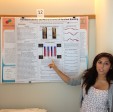Instead of tak ing time off between semesters, CMC students Sheila Panez ’15 and Jaanhvi Vaidya ’14 have been spending their summer researching foot mechanics and neurological connections. On July 18, they and other students from the 5Cs presented their progress in poster presentations at the Keck Center.
ing time off between semesters, CMC students Sheila Panez ’15 and Jaanhvi Vaidya ’14 have been spending their summer researching foot mechanics and neurological connections. On July 18, they and other students from the 5Cs presented their progress in poster presentations at the Keck Center.
The research, supported by a 3.6 million dollar grant from the Howard Hughes Medical Institute to the Claremont Colleges in 2012, encourages collaboration between professors and students and gives students an opportunity to learn how to properly conduct scientific research.
“Faculty train students in the scientific method and emphasize the importance of communication with fellow scientists as well as non-experts” says Dr. Bidushi Bhattacharya, Director of Sponsored Research and Research Programs, Keck Department of Sciences. “Students often publish articles in professional journals, after rigorous review by prominent scientists in the field.”
Are your feet aching this summer? Sheila Panez ’15 may have a solution after researching the differences between running barefoot and running with shoes. Research which may be helpful in preventing injuries.
Panez, under the guidance of Harvey Mudd College associate professor of biology Anna Ahn, has been experimenting with the biomechanics of barefoot running, working with two other students from HMC.
Barefoot running is becoming more and more popular due to the realization that our ancestors ran faster and farther with fewer injuries and without shoes, according to Panez. She found that when running barefoot, subjects tended to forefoot strike-hit the ground first with toes, but when running with shoes, subjects tended to heel strike. The cushioning of shoes allows runners to land on their heels without experiencing the pain they would feel if they did the same barefoot.
They also found that in the barefoot condition, two hamstrings and two calf muscles were activated earlier to cushion the landing impact. Hip angles and knee angles were the same under both conditions, but the ankle angle was smaller in the barefoot condition.
“There’s this belief that shoes are helpful, but shoes have actually altered how we run, decreasing our efficiency,” says Panez.
Student Jaanhvi Vaidya is conducting research on neural connectivity with William R. Kenan Jr. Professor of Computational Neuroscience, John Milton, Keck Science Department. While there is already plenty of neural connectivity research out there, there is very little on time delayed neural networks, according to Vaidya. Understanding these networks could be crucial to understanding diseases such as epilepsy.
Vaidya is working with professor Milton on writing a computer program to model neural networks, which will allow them to simulate and analyze the neural networks. While still in the early stages, the researchers hope their work will ultimately lead to breakthroughs in the understanding of epilepsy, and maybe someday help with treatment of the disease.
“I am getting the opportunity to participate in ground-breaking research in a field that interests me,” says Vaidya. “And I will get to share this and learn about other interesting work at [a mathematical biological] conference, all while gaining invaluable experience and the opportunity to network with people who may help me with my career or graduate school in the future.”
About the W.M. Keck Science Department
The W.M. Keck Science Department is the interdisciplinary home to all biology, chemistry, and physics faculty for Pitzer, Claremont McKenna and Scripps colleges. The department is administered cooperatively and is housed within an 81,000-square-foot center located at the intersection of the three colleges. The department offers 14 discrete degree options, including dual-degree programs in partnership with schools of engineering and majors in conjunction with disciplines outside the sciences. The W.M. Keck Science Department provides comprehensive, interdisciplinary instruction in small class settings and numerous opportunities for students to conduct research.
